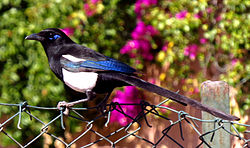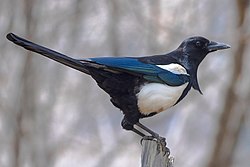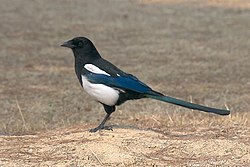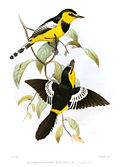| Pica Temporal range: | |
|---|---|
 | |
| Eurasian magpie (P. pica) | |
| Scientific classification | |
| Domain: | Eukaryota |
| Kingdom: | Animalia |
| Phylum: | Chordata |
| Class: | Aves |
| Order: | Passeriformes |
| Family: | Corvidae |
| Subfamily: | Corvinae |
| Genus: | Pica Brisson, 1760 |
| Type species | |
| Corvus pica Linnaeus, 1758 | |
| Species | |
Pica is a genus of seven species of birds in the family Corvidae in both the New World and the Old. It is one of several corvid genera whose members are known as magpies. Pica have long tails and predominantly black and white markings. After Corvus, this genus is the second most widespread within the Corvidae family, being distributed across Eurasia, north Africa, and western North America. [1] Molecular phylogeny suggests that Pica is most closely related to nutcrackers ( Nucifraga ), jackdaws ( Coloeus ) and crows and ravens ( Corvus ). [2]



















